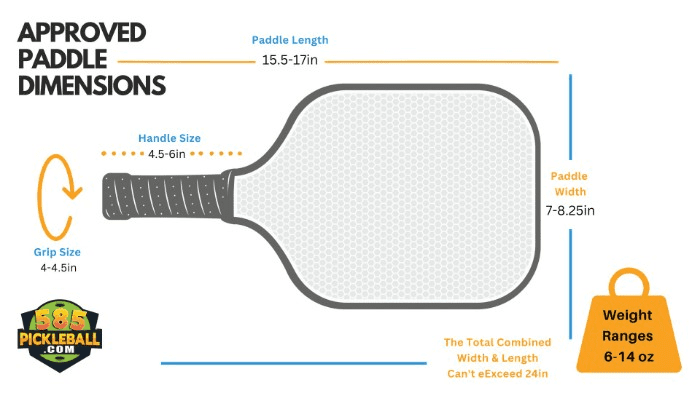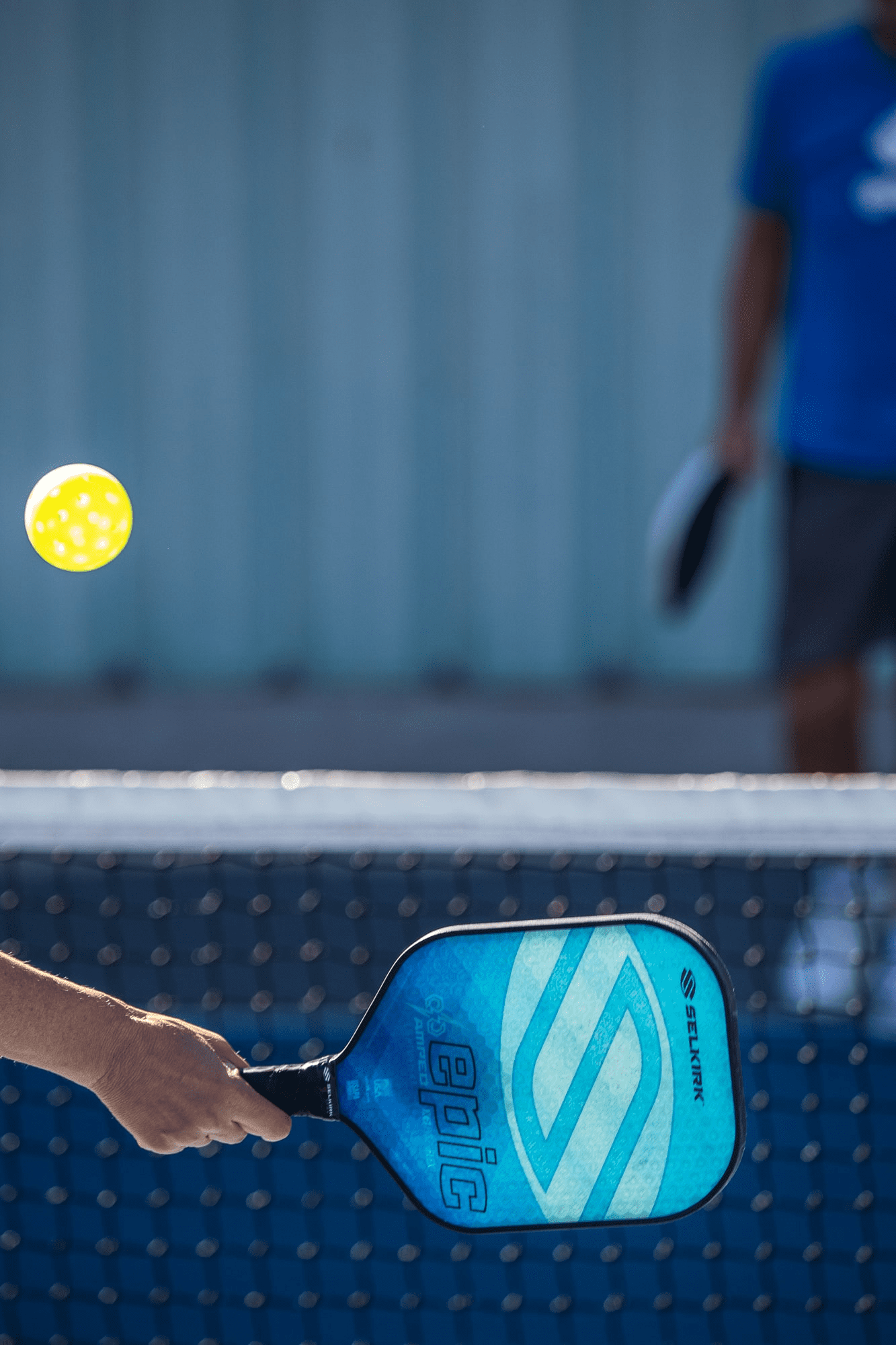When playing pickleball, it’s crucial to have the right size paddle for your game. The dimensions of a pickleball paddle can affect your play style and how well you perform during the game. Knowing the different pickleball dimensions can help you choose the right paddle.
Are you moving over from tennis? Do you like a larger sweet spot? Are you a short game player or prefer deep ball shots? All these questions can help you determine what the best pickleball paddle is right for you. Today we will cover everything you want to know (and maybe some things you don’t:) about the dimensions of a pickleball paddle.
Let’s Jump In!
Table of Contents
ToggleWhat is the Standard Size of a Pickleball Paddle?
Paddle manufacturers today are innovating pickleball paddle’s weight, size, shape, and core materials to provide so many options it can make your head spin. Trying to determine the difference between the paddles takes a lot of work. How do I distinguish the different paddles?
Keep grip size and weight in mind, as you may be looking for a new pickleball paddle. Each paddle has a unique feel; some are designed for more power, while others emphasize control. You’ll find paddles available in many shapes and sizes. Here are the official paddle rules laid out by the USAPA:

Rule – 2.E.3. Size.
The combined length and width, including any edge guard and butt cap, shall not exceed 24 inches. The paddle length cannot exceed 17 inches, and there is no restriction on paddle thickness.
Official Pickleball Paddles Dimensions:
-
Overall maximum paddle length: 15.5-17in
-
The total combined width and length can not exceed 24in
-
Width: 7-8.25in
-
Typical depth: .4-.7in
-
Length of handle: 4- 6in
-
Grip size between 4-4. 5in
-
Standard pickleball paddle weight ranges from 6-14 oz
These rules are standardized and followed by all the major pickleball makers. If you are playing in pickleball tournaments or regulated games, it is crucial to ensure that your pickleball paddle meets all the requirements the USAPA sets forward. Below we’ll go over all the factors that make up an approved pickleball paddle and things to avoid.
Can You Use a Homemade or Custom Pickleball Paddle?
The rules surrounding homemade pickleball paddles say you can not make your own. In the early days of pickleball, wood paddles were the only way to play, and the handle was wrapped with tennis grips. But today, these types of paddles are no longer allowed. Custom pickleball paddles, however, are acceptable as long as they adhere to the size and weight specifications set by the USAPA.
Rule – 2.E.8.
Homemade Paddles. Paddles not commercially made are not permitted (e.g., homemade paddles).
If you are looking for a custom pickleball paddle, you can find a manufacturer who will follow the official pickleball paddle dimensions. A custom pickleball paddle that meets the specifications of the USAPA will ensure that your paddle is legal for all pickleball tournaments and regulated games. You can customize a pickleball paddle in many ways, including graphics, weight, grip, and more. We have a complete guide on some of the best-customized paddle manufacturers on the market.

Do Pickleball Paddles Come in Different Sizes?
Yes, there are many paddle shapes and widths, but they should all fall within the guides mentioned above. Elongated paddles, wide body, and more. Below are the most common paddle shapes you will see; again, cross-reference the stats I gave above.
Common Paddle Shape:
-
Standard: has a longer handle, giving your swing more force.
-
Impact: will maximize power with a larger sweet spot.
-
Elongated: paddle gives players a longer reach and is great for tennis players moving over to pickleball.
-
Wide body: has a large sweet spot for more power in your shots.
-
Oversized: it is not as large as a wide body but has a more concentrated sweet spot.
-
Tear Drop: this is balanced power and excellent for players moving from racquetball or squash as the paddle shape will be familiar.
Pickleball Paddle Core Thickness
There are currently no restrictions on the thickness of pickleball paddles or the materials used within the core. The thickness of a paddle is inversely proportional to the amount of spring. In other words, thinner paddles have more spring, while thicker ones absorb shock, giving you more control over your shots.
Pickleball Paddle Weight
When trying to find the right pickleball paddle, weight is one of the most crucial aspects, and many businesses provide adjustable paddle weights. Weights generally vary from 6-14 ounces; heavyweight pickleball paddles will result in more powerful swings. A lighter paddle lets you be more precise with ball placement and makes it easier to maneuver.
However, before buying a paddle, try different weights and paddles from friends to know what weight works best for you. Most companies also let you return or exchange the paddle if unsatisfied.
Pickleball Paddle Face
The composite paddles use the latest material technology, allowing for increased playability. Combining touch, feel, and strength, a fiberglass face provides more power than graphite paddles.
A pickleball player looking for a mix of durability, soft touch, and control over the ball should buy a fiberglass paddle. Fiberglass also enhances spin shots because of how the paddle face is textured. By incorporating spin into your pickleball game, you can take your playing to the next level.
Check out our latest post graphite or fiberglass composite pickleball paddles for a full breakdown.
Paddle Handle Length
The handle length can span from 4.5 to 6 inches, which then changes the surface area of the paddle face. The longer the handle, the less space available for striking actions on the paddle’s face because of the overall length restrictions.
What Are The Restrictions of a Pickleball Paddle?
There are some restrictions that the USAPA has imposed in their rule book when finding a good pickleball paddle. Firstly, the hitting surface should not have any holes or indentations that could aid in spinning the ball. It also should be smooth – this is measured using a Starrett SR160 Surface Roughness Tester and must be within certain limits.
Do you know your pickleball rating? Learn how the system works.
USAPA Restrictions:
-
Anti-skid paint or any paint textured with sand, rubber particles, or any material that causes additional spin.
-
No rubber and synthetic rubber can be used.
-
Sandpaper characteristics.
-
Moving parts that can increase head momentum.
-
No removable parts except for paddle grip adjustments or 9 USAPA & IFP Official Rulebook grip wraps and lead tape on the paddle edge.
-
No springs or spring-like material.
-
Flexible membranes or any compressible material create a trampoline effect.
-
Electrical, electronic, or mechanical assistance of any sort.
The paddle face can be painted or have graphics, but it must adhere to these guidelines. All images or writing on the paddle should be appropriate. Additionally, the paddle face should not have any reflective qualities that could distract other players.
You may make only changes or additions to a commercially made paddle: edge guard tape, lead tape, grip size, or grip wrap changes. Name decals or other identification markings on the paddle face are also allowed.
Read our full comparison of pickleball vs. tennis next

Grip Size of Pickleball Paddle
Besides grip sizes, pickleball paddle dimensions can affect pickleball paddle performance. Usually, the pickleball paddle is around four inches in diameter. Identifying the right pickleball grip size helps reduce tennis elbow or sprains in the hands. Read our guide on pickleball grips to find out how to measure them and which one might be best for you.
How Does the Core and Its Thickness Impact a Paddle?
The body of the paddle is more critical to its performance than its face, and the surface thickness of the paddle is also a key factor. Keep this in mind when looking for paddles. Usually, aggressive players use thinner poly cores. If you’re more focused on gaining control than power, you will want thicker 16 mm paddles.
Types Of Core Materials
There are three main pickleball paddle cores on the market: aluminum, Nomex, and polymer/ composite paddle.
An aluminum core is the lightest option on the market, making them great for speed-focused players. They usually have a good response time and help you generate more power. However, they are the most fragile pickleball paddle cores and can dent or break more easily than other materials.
Nomex pickleball paddle cores are a popular option for players who want a durable pickleball paddle that can withstand more punishment. They’re not as light as aluminum cores but provide better ball control and are less likely to bounce off the court.
Polymer pickleball paddle cores are the heaviest option on the market, but they also offer the best ball control. The polymer is the best option if you’re looking for a pickleball paddle with a large sweet spot.
Price of Pickleball Paddle
Most pickleball paddles typically fall between $40 and $200. Cheaper paddles can be found for less than $50, while high-quality paddles may cost around $150. Generally speaking, the price of a paddle depends on the amount of pickleball you expect to play, what materials, and the brand. I recommend getting a mid-range paddle for first-time buyers between 50 and 75 dollars.
Best Pickleball Paddles for Beginners
The first thing to consider when choosing a pickleball paddle is the size. Starting with a paddle on the larger side is best if you’re a beginner, so you have more surface area to hit the ball. As you get more experience, you can move to a smaller paddle for more control.
The weight of a pickleball paddle is something you should carefully consider. Most paddles weigh between 6 and 10 ounces, averaging around 7.5 ounces. Starting, it’s best to use a mid weight paddle so it’s easy to swing, but you still have control over the ball.
In Conclusion
Pickleball paddles come in various sizes and weights, and it is important to select the right size paddle for your game to improve your performance. The dimensions of a pickleball paddle can affect your play style and how well you perform during the game. Knowing the different pickleball dimensions can help you choose the right paddle.
Additionally, the surface thickness of the paddle is also a key factor in its performance. Paddles typically fall between $40 and $200, with cheaper paddles costing less than $50 and high-quality paddles costing around $150. I recommend getting a mid-range paddle for first-time buyers between 50 and 75 dollars.
Hopefully, we have shed some light on the subject, and you are now ready to play pickleball with the right equipment!
Read Next: Pickleball Court Dimensions Post Here

